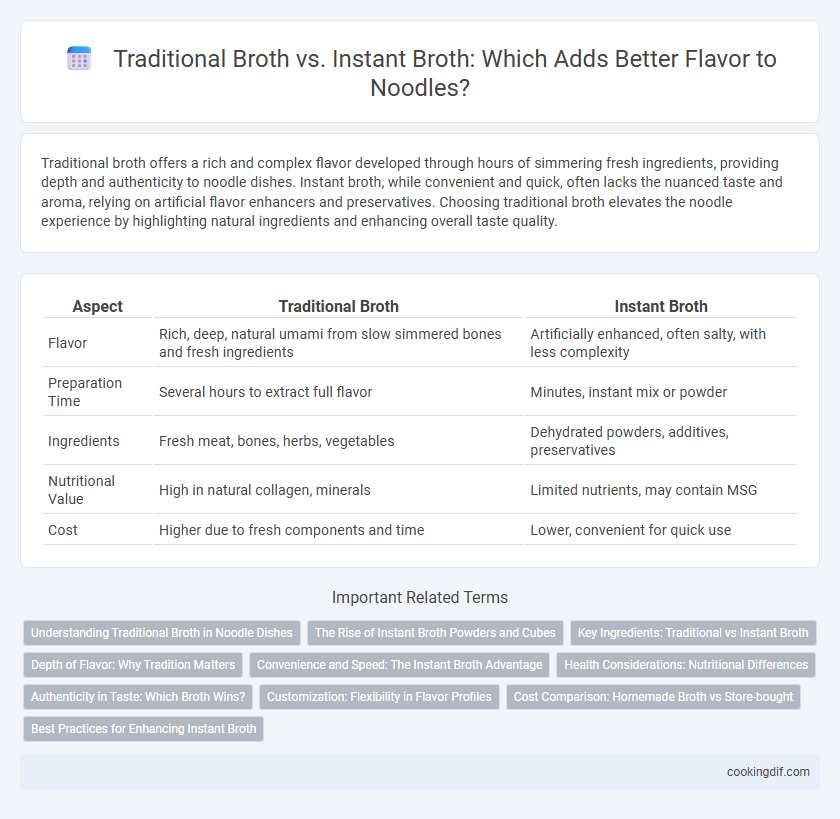Traditional broth offers a rich and complex flavor developed through hours of simmering fresh ingredients, providing depth and authenticity to noodle dishes. Instant broth, while convenient and quick, often lacks the nuanced taste and aroma, relying on artificial flavor enhancers and preservatives. Choosing traditional broth elevates the noodle experience by highlighting natural ingredients and enhancing overall taste quality.
Table of Comparison
| Aspect | Traditional Broth | Instant Broth |
|---|---|---|
| Flavor | Rich, deep, natural umami from slow simmered bones and fresh ingredients | Artificially enhanced, often salty, with less complexity |
| Preparation Time | Several hours to extract full flavor | Minutes, instant mix or powder |
| Ingredients | Fresh meat, bones, herbs, vegetables | Dehydrated powders, additives, preservatives |
| Nutritional Value | High in natural collagen, minerals | Limited nutrients, may contain MSG |
| Cost | Higher due to fresh components and time | Lower, convenient for quick use |
Understanding Traditional Broth in Noodle Dishes
Traditional broth for noodle dishes is simmered for hours using bones, vegetables, and aromatics to develop a deep, rich flavor profile that enhances the noodles' taste and texture. This slow-cooking process releases gelatin and natural umami compounds, creating a complex, savory base that elevates the overall dish. In contrast, instant broth often relies on artificial flavor enhancers and preservatives, lacking the depth and authenticity of traditional broth.
The Rise of Instant Broth Powders and Cubes
Instant broth powders and cubes have surged in popularity due to their convenience, long shelf life, and concentrated flavor profiles, making them a staple in quick noodle preparations. Traditional broth, typically simmered with bones, vegetables, and spices for hours, offers a richer and more complex taste but requires significant time and effort. The rise of instant broth products caters to modern lifestyles, balancing flavor enhancement with efficiency in noodle cooking.
Key Ingredients: Traditional vs Instant Broth
Traditional broth relies on simmering fresh bones, vegetables, and herbs for hours, extracting rich collagen, amino acids, and natural umami compounds that create a deep, complex flavor profile. Instant broth often contains hydrolyzed vegetable protein, artificial flavor enhancers like monosodium glutamate (MSG), and sodium-based preservatives, which provide convenience but lack the nuanced taste and nutritional benefits of slow-cooked broth. Key ingredients in traditional broth contribute to a wholesome, layered flavor, while instant broth prioritizes rapid preparation and shelf stability over authentic taste.
Depth of Flavor: Why Tradition Matters
Traditional broth offers a richer and more complex depth of flavor due to its slow simmering process, which extracts essential nutrients and umami compounds from bones, vegetables, and herbs. Instant broth, while convenient, often lacks the nuanced taste and mouthfeel developed through hours of cooking, resulting in a flatter, less satisfying flavor profile. The difference in depth of flavor is why chefs and noodle enthusiasts prioritize traditional broth for authentic and satisfying dishes.
Convenience and Speed: The Instant Broth Advantage
Instant broth offers unmatched convenience and speed, allowing for quick preparation without compromising basic flavor. Traditional broth requires hours of simmering to develop depth, making it less suitable for fast meals or busy lifestyles. Instant broth packets or cubes dissolve instantly, making them ideal for quick noodle dishes and on-the-go cooking.
Health Considerations: Nutritional Differences
Traditional broth offers richer nutrient content, including collagen, minerals, and amino acids that contribute to joint and gut health. Instant broth often contains higher sodium levels, preservatives, and artificial flavors, which may negatively impact cardiovascular health when consumed frequently. Choosing traditional broth supports better hydration and micronutrient intake, while instant options provide convenience but with potential trade-offs in nutritional quality.
Authenticity in Taste: Which Broth Wins?
Traditional broth offers a depth of flavor derived from slow simmering bones, herbs, and spices, resulting in a rich, umami-packed base that defines authentic noodle dishes. Instant broth, while convenient and consistent, often lacks the complex aroma and nuanced taste profiles that come from natural extraction processes. For true authenticity in taste, traditional broth remains unparalleled in delivering the genuine flavor experience prized in culinary traditions.
Customization: Flexibility in Flavor Profiles
Traditional broth offers unparalleled customization, allowing cooks to adjust ingredients, simmering time, and seasoning to create complex and nuanced flavors tailored to personal preferences. Instant broth provides convenience but often lacks the depth and flexibility, as flavors are pre-mixed and standardized, limiting the ability to modify taste profiles. For chefs seeking full control over the noodle dish's flavor, traditional broth remains the superior choice for achieving unique and adaptable flavor profiles.
Cost Comparison: Homemade Broth vs Store-bought
Homemade traditional broth typically incurs higher upfront costs due to fresh ingredients like bones, vegetables, and herbs but offers superior flavor depth and nutritional value compared to instant broth. Store-bought instant broth is more cost-effective and convenient, often priced lower per serving, yet may contain additives and less complex taste profiles. Evaluating cost per use, homemade broth yields greater flavor customization and bulk savings, while instant broth excels in affordability and quick preparation for everyday meals.
Best Practices for Enhancing Instant Broth
Instant broth can be significantly enriched by simmering it with fresh aromatics like garlic, ginger, and green onions, which enhance depth and complexity without the time investment of traditional broth. Incorporating a splash of soy sauce or miso paste adds umami, creating a richer, more authentic noodle soup experience. Balancing seasoning with a pinch of salt and a dash of sesame oil ensures the broth's flavor profile complements the noodles perfectly.
Traditional broth vs instant broth for flavoring Infographic

 cookingdif.com
cookingdif.com